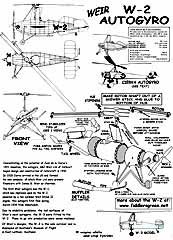
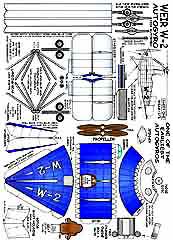
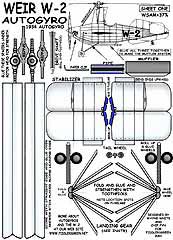
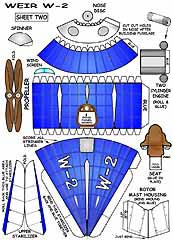
Autogyro-W2 - $$4.95
The Cierva C.2 was an experimental autogyro built by Juan de la Cierva in Spain in 1921-22. Following the failure of the C.1 the previous year, la Cierva started again from scratch, this time taking the fuselage from a Hanriot biplane and adding a five-bladed single rotor to it.
The Weir W-2 Autogyro
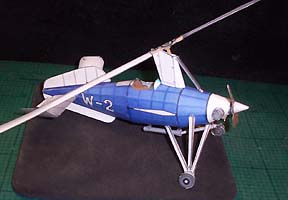 Designer Wayne White just 'had' to design this little auto gyro so design it he did! Let's hope he has it in him to pop out a few more of these historical Auto gyros.
Designer Wayne White just 'had' to design this little auto gyro so design it he did! Let's hope he has it in him to pop out a few more of these historical Auto gyros.
In 1932 G&J Weir Ltd of Cathcart constructed rotorcraft of indigenous design, focusing on the perceived potential of the autogyro, conceived by Spaniard Juan de la Cierva in 1921.
This single-seater was powered by an inverted 4-cylinder in-line engine and fitted with a two-bladed 'auto-dynamic' rotor. It could make a 'jump take-off': to do this, the rotor was run at overspeed in flat pitch then suddenly given sufficient positive pitch to produce the jump while the engine was declutched. The W.3 was publicly displayed at Hounslow Heath on 23rd July 1936
This is the real one posing for photo.. It now lives at the Scottish Museum of Flight
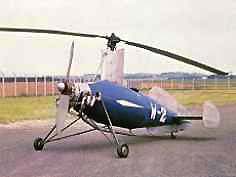
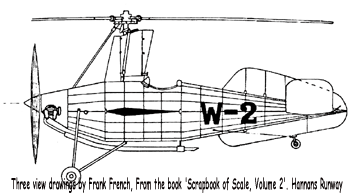
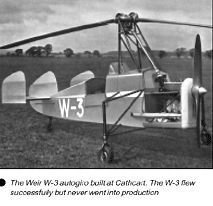 In 1928 Cierva
arrived in the United Kingdom and established his own company,
of which Weir Ltd was main financiers of, with James G. Weir as
chairman. The first Weir autogyro was the W-1, which was improved
upon by the W-2, powered by a two cylinder Weir Dryad II engine,
this autogyro first flew during March 1934 from Abbotsinch.
In 1928 Cierva
arrived in the United Kingdom and established his own company,
of which Weir Ltd was main financiers of, with James G. Weir as
chairman. The first Weir autogyro was the W-1, which was improved
upon by the W-2, powered by a two cylinder Weir Dryad II engine,
this autogyro first flew during March 1934 from Abbotsinch.
Due to stability problems, the tail surfaces of Weir's next autogyro, the W-3 were fitted to the W-2 and plans were afoot for production, which never materialized. Out of Weir's enterprising designs, the W-2 is the sole survivor, and was a part of the Science Museum collection for many years before being generously donated to the Museum of Flight by Viscount Weir as a unique part of Scotland's National Aviation collection in 1986. It arrived at East Fortune in 1974.
What is a Gyroplane...
"Gyroplane" is an official term designated by the
Federal Aviation Administration (FAA) describing an aircraft that
gets lift from
a freely turning rotary wing (rotor blades), and which derives
its thrust from an engine-driven propeller. Historically, this
type of
aircraft has been known as the autogiro and the gyrocopter. The
early names and variants were filed as trademarks.
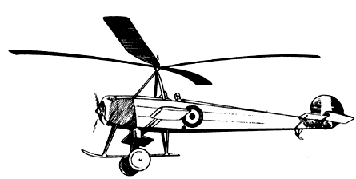
Gyroplanes derive lift from freely turning rotor blades tilted
back to catch the air. The rushing air spins the rotor as the
aircraft is thrust forward by an engine-driven propeller. Early gyroplanes
were powered by engines in a tractor (pulling) configuration and were relatively heavy. Modern gyroplanes use a pusher propeller
and are light and maneuverable. With the engine in the rear, the
gyroplane has unobstructed visibility.
A Gyroplane can fly more slowly than airplanes and will not stall. They can fly faster than helicopters but cannot hover. Since the rotor blades on the gyroplane are powered only by the air (autorotation), much like a windmill, there is no need for a tail rotor for anti-torque. The gyroplane is a stable flying platform. This is not so with helicopters, which pull the air down through engine-powered rotor blades making it possible to hover, but also making the aircraft very complicated and expensive to fly. Due to their inherent simplicity, gyroplanes are easier to operate and less expensive to maintain than helicopters.
Gyroplanes in flight are always in autorotation. If power fails
in a gyroplane the autorotation continues, and the aircraft settles
softly to the ground from any altitude. The procedure to land
after a power failure is the same procedure as a normal landing,
which requires no landing roll. Thus the gyroplane is a safer
aircraft for low and slow flight, as compared with both helicopters
and airplanes. The ability of gyroplanes to fly faster than helicopters
and slower than airplanes makes it something of a hybrid,
having the good qualities of the other two types of aircraft with
little of the bad.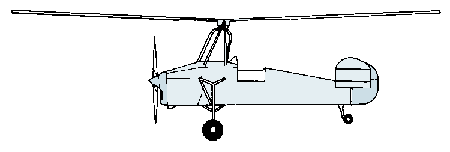
The single attraction of helicopters over gyroplanes is their ability to hover, which is necessary in some situations such as rescue or in sling load work. In air surveillance and point-to-point flying, not being able to hover is not a disadvantage because many gyroplanes, such as the Groen Brothers Hawks, take off and land vertically without having to hover. Helicopters at low altitude out of ground effect avoid hovering whenever possible. It is too dangerous. To fix surveillance on one spot, proper procedure for all rotorcraft is to circle in a slow orbit.
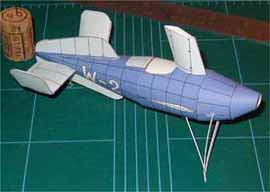 |
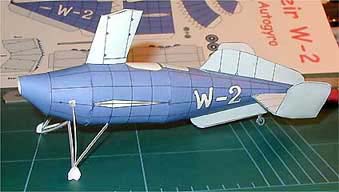 |
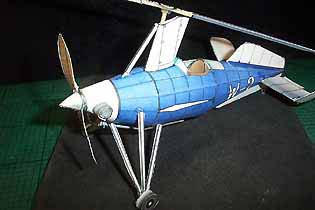 Chip's Final mock up |
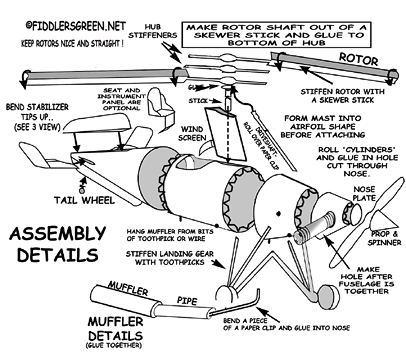
It was my good fortune to know the late Frank Courtney, who did much of the test-flying in England for Cierva, the late P.T. Capon, who helped with the Comper 'giros, and the late Doug Gillies, a fine aviation historian, modeller and a long-time staff member at the Wier company in Scotland. Doug showed me the W-2 in the museum during 1975, and introduced me to Rolls-Royce engineer Frank French, also now deceased, who was an avid aeromodeller. In 1984 we published Frank's 3-view drawing of the W-2 in our "Scrapbook of Scale, Volume 2.
Although it has been years since I heard first-hand descriptions of the Weir involvement with Cierva, I'll can offer you a brief "potted history" from memory, to give you at an inkling of the connections:
Frank Courtney first saw a Cierva Autogiro (correct spelling of anything built under Cierva's authorization, including the Weirs) in Spain, and after a time suggested that Cierva bring a machine to England for demonstration. Juan de la Cierva did not speak English at the time, and Frank did not speak Spanish, however both spoke French, so they communicated in that manner!
The Cierva brought to England was based upon an Avro fuselage, and Courtney helped arrange connections between Cierva and A.V. Roe, who's factory constructed many of the susequent 'giros for Cierva, most of which Courtney demonstrated. (Cierva was not a pilot until later).
The story is more complex than this, however somewhere along the way Courtney introduced Cierva to Jimmy Weir who then made some investments in the the Cierva projects, and eventually decided to manufacture some at the Weir factory. The Weir company was a big operation, manufacturing vital precision equipment for many of the world's navy vessels, so surplus cash was readily available. The Weir Autogiros were quite remarkable in several respects, not least because even the engines for them were custom manufactured. Anyhow, like much in aviation history, there were fascinating personal connections that are not generally known...
It is fun to note that model Autogiros and autogyros are again being modeled, after years of near-neglect. Having modeled a few small free-flight variations myself, I consider them to be among the most challenging subjects to fly ever encontered.
They can be frustrating in the extreme, but oh so rewarding when they do perform!
Best wishes, and keep up the great work! Cordially, Bill Hannan



